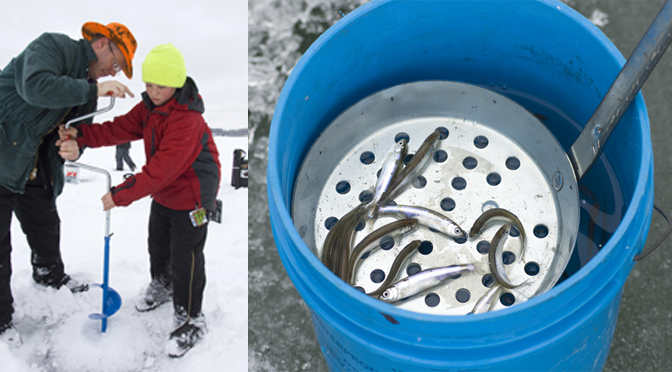Excerpts taken from Ice Fishing: The Coolest Sport Around, published by the Michigan Department of Nature Resources (DNR). To read the full article visit www.michigan.gov/dnr.
For many people, fishing is the most relaxing way to spend the day. And in the winter months the most popular angling activity is ice fishing. To those who have never tried it, ice fishing is sometimes looked upon as an oddity, but for others, ice fishing is the best kind of fishing.
With any outdoor activity, safety should be your top concern and when it comes to ice safety, you should steer clear of dark spots or places where the snow looks discolored. Some other good rules to follow include:
• Never fish alone
• Tell someone where you are going and when you expect to return
• Always test the ice with a spud
• Take the appropriate emergency items, such as a lifejacket and ice picks
• Take a cell phone with you in case you need to call for help.
To get started ice fishing, you’ll need the basics: something to make a hole in the ice (spuds and augers), something to clear the hole and keep it open and ice free (skimmer or a slush scoop), and something to fish with, or equipment. Ice fishing equipment can be divided into three basic categories: hook-and line, tip-ups and spears. The most common species hook-and-line ice fishermen are looking for are panfish: bluegill, sunfish, perch and crappie. Tip-ups are generally used for larger game fish, such as northern pike, walleye and various trout species. In Michigan, spear fishermen are allowed to target northern pike, muskellunge, lake sturgeon and many other species. There are many restrictions associated with spear fishing and anglers should read the annual Michigan Fishing Guide for more information.
A basic tip for all three ice fishing methods is that the most success is seen around dawn until mid-morning and again from late afternoon until sundown. This is especially true for panfish and walleye. Some species can be more aggressive at other times during the day, such as northern pike. It’s also important to understand that fish are more sluggish during the winter and move around less, especially during the middle of winter when ice thickness and snow cover is the heaviest. The more holes anglers cut and try, the better their chances are for locating aggressive fish.
Although the idea of going ice fishing may seem daunting, many fishing clubs and sporting goods stores hold annual ice fishing clinics where anglers can learn the basics. A number of Michigan state parks, interpretive centers and fish hatcheries also host programs during the winter months that teach basic techniques and offer hands-on experience.
Ice fishing may not be for everyone. But if you’ve ever driven by a Michigan lake in the winter and have seen the “shantytowns” out on the ice, you can tell plenty of people consider ice fishing to be a pretty cool sport.
[easy-social-share]

